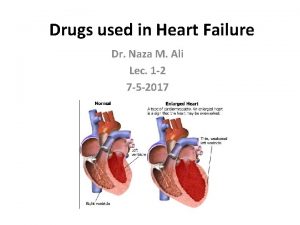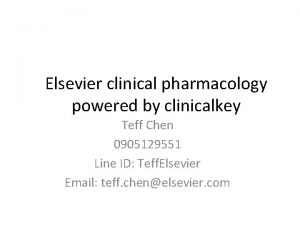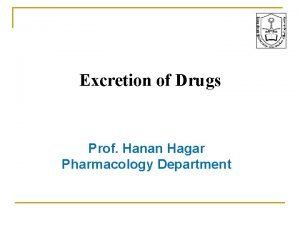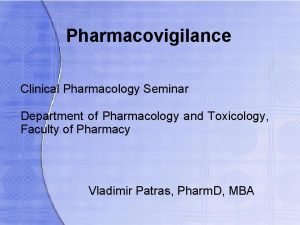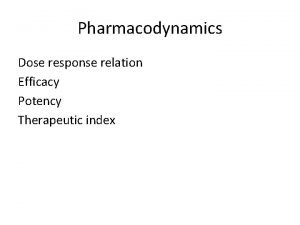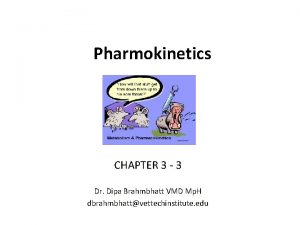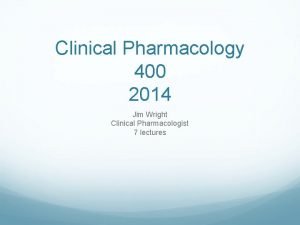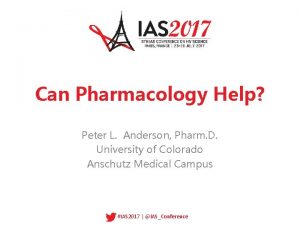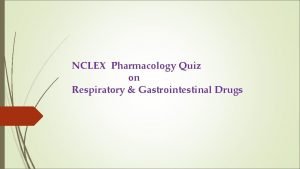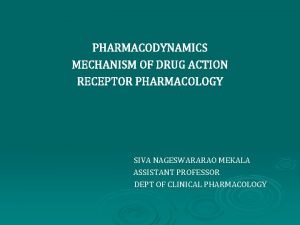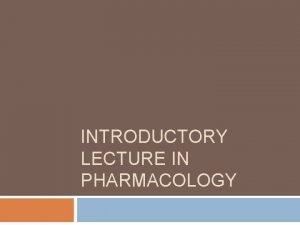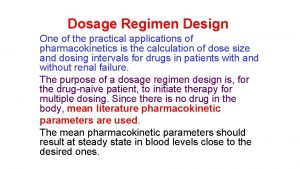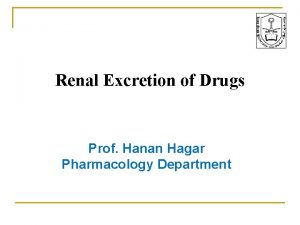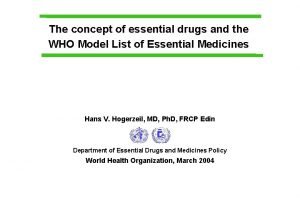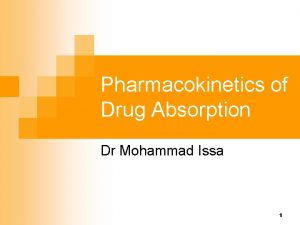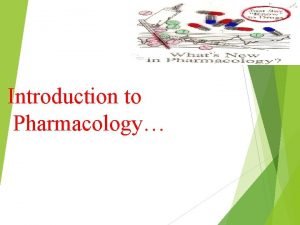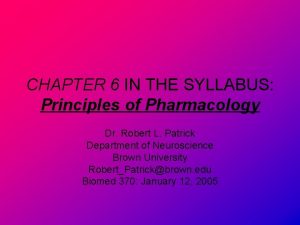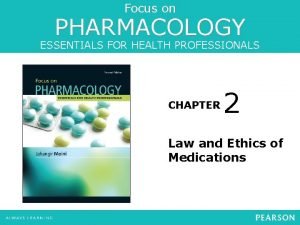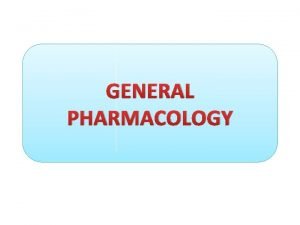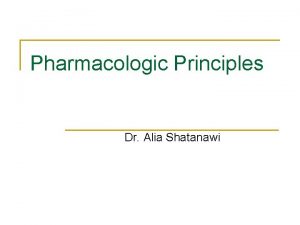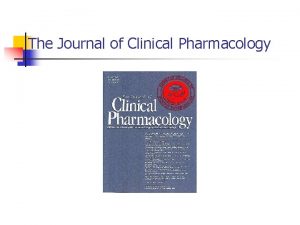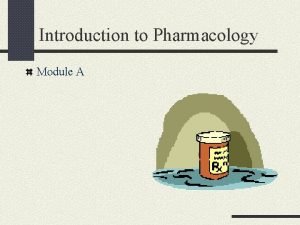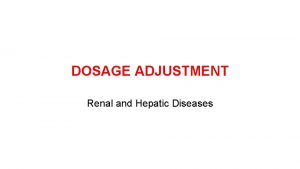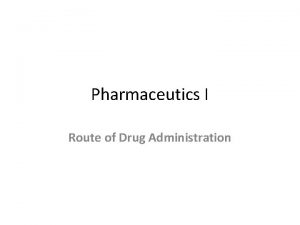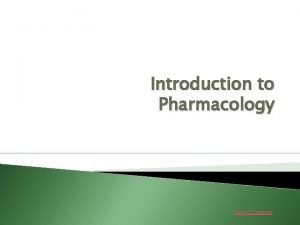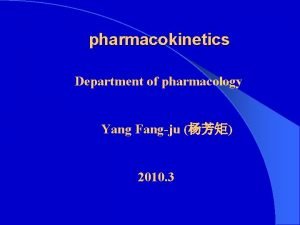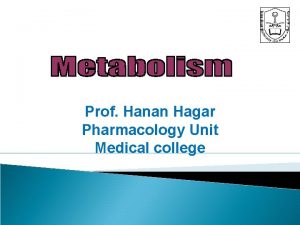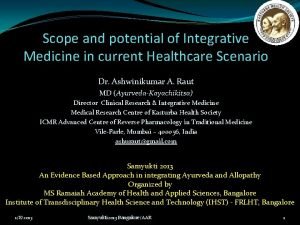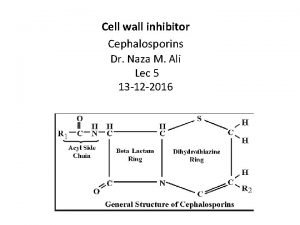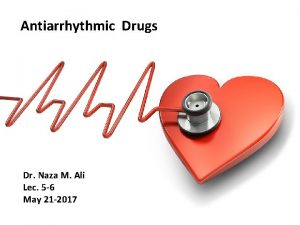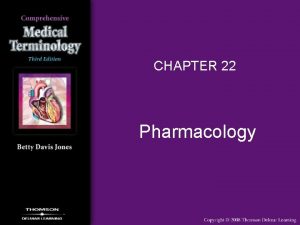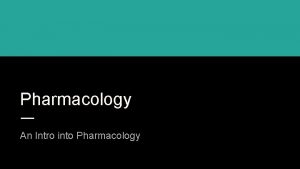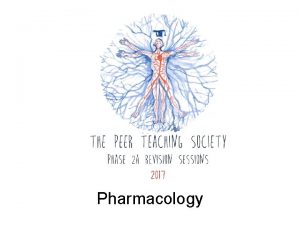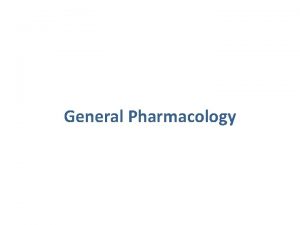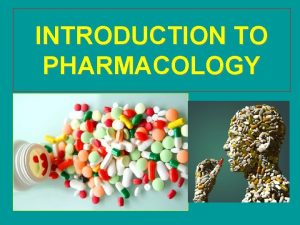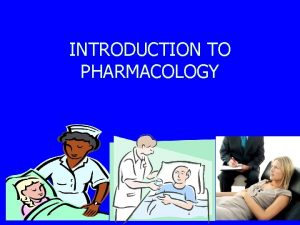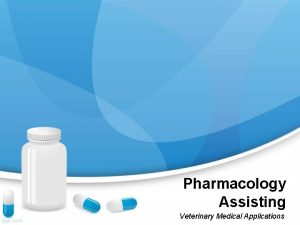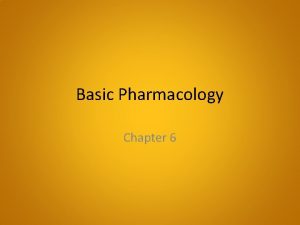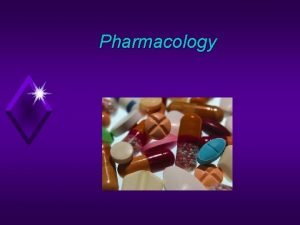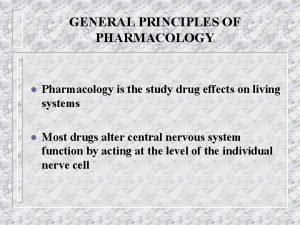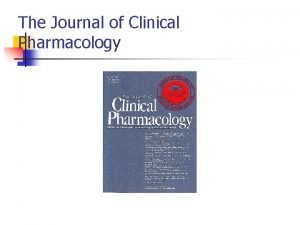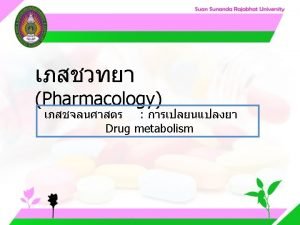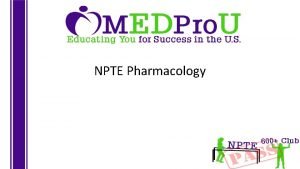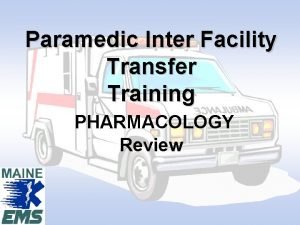Pharmacology Dr NAZA M Ali 5 12 2016

































- Slides: 33

Pharmacology Dr. NAZA M. Ali 5 -12 -2016 Lec 1

Pharmacology word has been derived from two Greek words: Ø Pharmakon mean drug Ø logos mean study Pharmacology is a science that studies the effects of drugs within a living system. Toxicology is the science of poisons, is the studies of the harmful effects of a chemicals on Living organisms.

There are two main branches of pharmacology: 1. Pharmacokinetics: It is concerned with the absorption, distribution, metabolism and excretion of drugs. Ø Pharmacokinetics is what the body does to the drugs.

2. Pharmacodynamics: it is concerned with the biochemical and physiological effects of drugs and their mode of action, it includes the dose-effect relationship, factors modifying drug effects and dosage, and drug toxicity. Ø Pharmacodynamics is what drugs do to the Body.

• A good knowledge of pharmacology (both pharmacokinetics & pharmacodynamics) is therefore necessary to use drugs safely and efficiently. • Pharmacy: is the science and art of preparing a drug or combination.

What is drugs? Ø A drug is a chemical that interacts with a living organism to produce a biological response. Ø Drugs in common include inorganic ions, nonpeptide organic molecules, nucleic acids lipids, carbohydrates, small peptides and proteins.

Sources of drugs 1. Naturally occurring compounds: these are extracted from plants and animals. 2. Modified natural drugs: some natural drugs can be modified in order to produce better and more efficacious drugs. 3. Mineral sources 4. Microbial sources 5. Synthetic sources 6. Genetic engineering

Orphan drugs: when a drug is not developed because the developer will not recover the costs, then it is known as orphan drug. • These are meant for diagnosis, prevention or treatment of rare diseases. Prodrug (inactive): There are some drugs which are inert until they are chemically altered within the body.

• Dose: it is defined as the quantity of drug which is sufficient to diagnose, prevent or treat a disease. • Dosage: it is the schedule of dose, frequency and duration of administration of drugs. • Pharmacogenetics: is concerned with variations in drug response due to genetic factors.

• The goal of drug therapy is to prevent, cure, or control various disease states. • To achieve this goal, adequate drug doses must be delivered to the target tissues so that therapeutic yet nontoxic levels are obtained.

First, The drug absorption from site of administration (Absorption) permits entry of therapeutic agent (directly or indirectly) into plasma. Second, the drug may then reversibly leave the bloodstream & distribute into the interstitial and intracellular fluids (Distribution). Third, the drug may be metabolized by the liver, kidney, or other tissues (Metabolism). Finally, the drug and its metabolites are removed from the body in urine, bile, feces (Elimination).

Pharmacokinetics

Routes of Drug Administration The route of administration is determined by: • The properties of the drug ( water or lipid solubility, ionization, etc. ) • The therapeutic objectives ( a rapid onset of action Or the need for long-term administration or restriction to a local site). There are two major routes of drug administration: Ø Enteral Ø Parenteral

A. Enteral : oral, sublingual B. Pareneral: IV, IM, SC C. Other: inhalation, intranasal, intrathecal, epidural, topical, transdermal, rectal, vaginal


A) Enteral administration 1. Oral: Ø advantages -oral drugs are easily self-administered -limit the number of systemic infections that could complicate treatment -toxicities or overdose by oral route may be overcome with antidotes

Ø Disadvantage - complicated, - the drug is exposed to harsh (GI) environments that may limit its absorption. - some drugs are absorbed from the stomach - the duodenum is a major site of entry to the systemic circulation because of its larger absorptive surface.

- most drugs absorbed from the GI tract enter the portal circulation and encounter the liver before they are distributed into the general circulation. - these drugs undergo first-pass metabolism in the liver, they may be extensively metabolized before entering the systemic circulation. - First-pass metabolism by the intestine or liver limits the efficacy of many drugs when taken orally.

2. Sublingual: placement under the tongue allows a drug to diffuse into the capillary network and to enter the systemic circulation directly. advantages -rapid absorption, -convenience of administration, -low incidence of infection, -avoidance of the harsh GI environment, -avoidance of first-pass metabolism.

Disadvantage -Not suitable of large volume -Not suitable for drug of low lipid/water partition coefficient


B) Parenteral routes The three major parenteral routes are: 1)Intravascular (intravenous or intra-arterial) 2)Intramuscular 3)Subcutaneous

Intravenous Injection / IV • For drugs that are not absorbed orally • The drug avoids the GI tract and first-pass metabolism by the liver • IV delivery permits a rapid effect and a maximal degree of control over the circulating levels of the drug. Disatvantage • When are injected cannot be recalled by strategies as emesis • Contamination at the site of injection. • IV injection may also induce hemolysis or too-rapid delivery of high concentrations of drug to the plasma and tissues.

Intramuscular / IM • Drugs can be aqueous solutions or specialized depot preparations often a suspension of drug in a nonaqueous vehicle (polyethylene glycol). • Absorption of drugs in an aqueous solution is fast, while, that from depot preparations is slow.

Subcutaneous SC • like that of IM injection, requires absorption and is slower than the IV route. • SC minimizes the risks associated with intravascular injection (minute amounts of epinephrine are combined with a drug to restrict its area of action). EX. Programmable mechanical pumps that can be implanted to deliver insulin in diabetic patients.

C)Other 1. Inhalation: Ø Inhalation provides the rapid delivery of a drug across the large surface area of the mucous membranes of the respiratory tract. Ø This route of administration is used for drugs that are gases ( some anesthetics) or those that can be dispersed in an aerosol. Ø effective and convenient for patients with respiratory complaints as asthma, because the drug is delivered directly to the site of action and systemic side effects are minimized. Ø EX. corticosteroids, such as fluticasone.

2. Intranasal: administration of drugs directly into the nose Ø Agents include nasal decongestants, Ø The anti-inflammatory corticosteroid mometasone Ø Desmopressin used intranasally in the treatment of diabetes insipidus

3. Intrathecal Ø Introduce drugs directly into the cerebrospinal fluid, so by pass BBB and it has a rapid effect spinal anesthesia Ø Amphotericin B is used in treat cryptococcal meningitis 4. Topical: Ø Topical application is used when a local effect of the drug is desired. Ø Clotrimazole is applied as a cream directly to the skin in the treatment of dermatophytosis, Ø Tropicamide drop(directly into the eye to dilate the pupil).

5. Transdermal: Ø This route of administration achieves systemic effects by application of drugs to the skin, via a transdermal patch. Ø The rate of absorption can vary markedly, depending on the physical characteristics of skin at the site of application. Ø This route is most often used for the sustained delivery of drugs, such as a. the antianginal drug nitroglycerin, b. the antiemetic scopolamine, c. the once-a-week contraceptive patch

6. Rectal: Ø 50% of the drainage of the rectal region by passes the portal circulation, so metabolism of drugs by the liver is minimized. Ø Preventing the destruction of the drug by intestinal enzymes or by low p. H in the stomach. Ø Is useful if the drug induces vomiting, when given orally or if the patient is already vomiting Ø or if the patient is unconscious Disadvantage Rectal absorption is often erratic and incomplete, and many drugs irritate the rectal mucosa.

7. Vaginal: Drugs may be administered locally in the vagina the form of pessaries. Example: antifungal vaginal pessaries

Epidural route: the drug administered by small catheter into epidural space of the spinal column, it is has a rapid onset of action (opioids). Intra articular: the drug directly to the synovial cavity of the joint, reduce inflammation and maintain joint mobility. Intra peritoneal: into the peritoneal cavity (lower half of abdomen), rapid absorption

 Dr naza
Dr naza Nosac samuel analiza likova
Nosac samuel analiza likova Clinical pharmacology powered by clinicalkey
Clinical pharmacology powered by clinicalkey What is ion trapping in pharmacology
What is ion trapping in pharmacology Clinical pharmacology seminar
Clinical pharmacology seminar Potency vs efficacy
Potency vs efficacy First pass effect drugs
First pass effect drugs Clinical pharmacology residency
Clinical pharmacology residency Toxicology and applied pharmacology
Toxicology and applied pharmacology Pharmacology tutor anderson
Pharmacology tutor anderson Respiratory pharmacology quiz
Respiratory pharmacology quiz Receptors in pharmacology
Receptors in pharmacology What is pharmacology
What is pharmacology Maintenance dose definition
Maintenance dose definition What is ion trapping in pharmacology
What is ion trapping in pharmacology Concept of essential drugs
Concept of essential drugs Bioavailability calculation example
Bioavailability calculation example Branches of pharmacology
Branches of pharmacology Pharmacology of drugs acting on respiratory system
Pharmacology of drugs acting on respiratory system What is pharmacology
What is pharmacology Adrenal drugs pharmacology
Adrenal drugs pharmacology Diazepa
Diazepa Volume of distribution
Volume of distribution What is pharmacology
What is pharmacology Annual review of pharmacology and toxicology
Annual review of pharmacology and toxicology Pharmacology and venipuncture in radiology pdf
Pharmacology and venipuncture in radiology pdf Clinical pharmacology
Clinical pharmacology Pharmacology module
Pharmacology module Dose adjustment in renal and hepatic disease
Dose adjustment in renal and hepatic disease First pass effect in pharmacology
First pass effect in pharmacology Slidetodoc. com
Slidetodoc. com Bioavailability
Bioavailability Metabolism of drug definition
Metabolism of drug definition Samyukti meaning
Samyukti meaning
